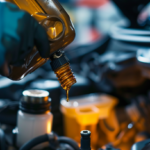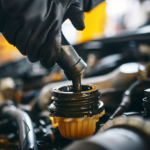Are you wondering how to keep your car’s brake system in top shape? Look no further! In this article, we’ll guide you through the essential steps to maintain your brakes and ensure your safety on the road. From recognizing signs of wear and tear to regular inspections and changing brake pads, we’ve got you covered. So, let’s dive in and learn how to extend the lifespan of your car’s brake system!
Importance of Brake Maintenance
You should prioritize the regular maintenance of your car’s brake system. Proper brake maintenance is essential for the safety and performance of your vehicle. Neglecting to maintain your brakes can lead to serious accidents and costly repairs. By regularly inspecting and servicing your brake system, you can identify and address potential issues before they become major problems. This includes checking the brake pads and rotors for wear and tear, ensuring proper fluid levels, and examining the brake lines for any signs of leaks or damage. Additionally, regular brake maintenance can help prolong the lifespan of your brake components and improve overall braking efficiency. Don’t wait for your brakes to fail before taking action – make brake maintenance a priority to ensure a smooth and safe ride.
Signs of Brake Wear and Tear
You need to be aware of the warning signs that indicate your car’s brake system is wearing out. These signs may include squealing or grinding noises, a spongy brake pedal, or longer stopping distances. Regular maintenance is crucial to ensure the safety and performance of your brakes, so don’t ignore these warning signs and make sure to schedule routine check-ups with a qualified mechanic.
Warning Signs to Recognize
Feeling a pulsating sensation in the brake pedal? It could be a sign of brake wear and tear. Recognizing warning signs is crucial to maintaining your car’s brake system. Another common warning sign is a squealing or screeching noise when you apply the brakes. This could indicate that the brake pads are worn out and need to be replaced. Additionally, if you notice that your car takes longer to stop or if you have to press the brake pedal harder than usual, it may be a sign of brake system deterioration. Another red flag is a burning smell coming from your brakes, which could mean that the brake pads are overheating. Lastly, if you feel a soft or spongy brake pedal, it could indicate air in the brake lines. Being aware of these warning signs and promptly addressing them can help prevent brake system failure and ensure your safety on the road.
Importance of Regular Maintenance
Recognize the signs of brake wear and tear to ensure the importance of regular maintenance for your car’s brake system. Regular maintenance is crucial for keeping your brake system in optimal condition and ensuring your safety on the road. Ignoring signs of brake wear and tear can lead to serious consequences, such as decreased braking performance and even brake failure. One of the most common signs of brake wear is squeaking or grinding noises when you apply the brakes. This indicates that the brake pads are worn down and need to be replaced. Other signs include vibrations or pulsations in the brake pedal, a soft or spongy brake pedal, or a longer stopping distance. If you notice any of these signs, it’s important to have your brakes inspected and serviced as soon as possible to prevent further damage and ensure your safety while driving. Regular maintenance will not only prolong the lifespan of your brake system but also give you peace of mind knowing that your brakes are in good working condition.
Regular Brake Inspections
Schedule regular brake inspections to ensure the safety and performance of your vehicle. Regular brake inspections are crucial for maintaining the integrity of your car’s brake system. By having your brakes inspected regularly, you can identify and address any potential issues before they become major problems. During the inspection, a trained technician will thoroughly examine your brake pads, rotors, calipers, and brake lines to check for signs of wear, damage, or leaks. They will also measure the thickness of the brake pads and assess the overall condition of the braking system. If any issues are found, they can be repaired or replaced promptly to prevent further damage and ensure that your brakes function properly. Remember, regular brake inspections are an essential part of vehicle maintenance and should never be overlooked.
Changing Brake Pads and Rotors
When it comes to changing your car’s brake pads and rotors, there are a few important points to keep in mind. First, make sure to pay attention to the proper pad wear indicators, which will let you know when it’s time for a replacement. Additionally, always refer to the rotor thickness specifications provided by your vehicle’s manufacturer to ensure a proper fit and optimal braking performance.
Proper Pad Wear Indicators
Make sure you regularly inspect the brake pads on your car to ensure they are wearing evenly and not causing any damage to the rotors. Brake pads have built-in wear indicators that make it easy to determine when they need to be changed. These indicators are small metal tabs that come into contact with the rotors when the brake pads become too thin. When you hear a high-pitched squealing noise while applying the brakes, it is a clear sign that the pads are worn down and need to be replaced. Ignoring this warning can lead to further damage to the rotors, resulting in a more expensive repair. Therefore, it is crucial to pay attention to these wear indicators and change the brake pads promptly to maintain the safety and performance of your car’s braking system.
Rotor Thickness Specifications
To ensure proper brake performance, you should be aware of the rotor thickness specifications when changing brake pads and rotors. The rotor thickness is an important factor that directly affects the braking system’s efficiency and effectiveness. When replacing brake pads, it is crucial to measure the rotor’s thickness and compare it to the manufacturer’s specifications. The rotor thickness should be within the recommended range to ensure optimal braking performance. If the rotor thickness is below the minimum specification, it may result in decreased braking power and potentially compromise your safety on the road. On the other hand, if the rotor thickness exceeds the maximum specification, it can cause uneven wear on the brake pads and lead to pulsation or vibration when braking. Therefore, always consult your vehicle’s manual or contact a professional technician to ensure that the rotor thickness is within the recommended specifications when changing brake pads and rotors.
Flushing Brake Fluid
You should regularly flush out your car’s brake fluid to ensure optimal performance. Flushing the brake fluid involves removing the old fluid and replacing it with fresh fluid. Over time, brake fluid can become contaminated with moisture, dirt, and debris, which can affect the performance of your brakes. Flushing the brake fluid helps to remove these contaminants and maintain the proper functioning of your brake system.
To flush the brake fluid, start by locating the brake fluid reservoir under the hood of your car. Use a turkey baster or a syringe to remove as much of the old fluid as possible. Then, refill the reservoir with new brake fluid. To flush the entire system, you will need to bleed the brake lines. This involves opening the bleeder valves on each brake caliper and allowing the old fluid to drain out while refilling with fresh fluid.
Flushing the brake fluid is a simple and important maintenance task that should be performed regularly to ensure the safety and effectiveness of your car’s brake system.
Tips for Extending Brake System Lifespan
By regularly inspecting and replacing worn brake pads and rotors, you can significantly extend the lifespan of your car’s brake system. It is important to keep an eye on the condition of your brake pads, as they are responsible for creating the friction necessary to slow down and stop your vehicle. If you notice that the brake pads have become thin or worn down, it is crucial to replace them promptly. Additionally, inspect the brake rotors for any signs of damage or warping. If the rotors are worn or uneven, they can cause vibrations or reduced braking performance. By addressing these issues early on, you not only improve the safety of your vehicle but also prevent further damage to the brake system, ultimately extending its lifespan.

Lucas is an experienced vehicle technician with hands-on knowledge of almost every car brand available. Throughout his career, Lucas has worked on a wide range of vehicles, including domestic and foreign models, sports cars, trucks, and SUVs.





